 |
|
 |
| |
發行人:林恭如所長 編輯委員:吳肇欣教授 主編:林筱文 發行日期:2016.10.31 |
| |
|
 |
|
 本所黃建璋教授榮膺「2017 OSA Fellow」,特此恭賀!
本所黃建璋教授榮膺「2017 OSA Fellow」,特此恭賀!
 本所林恭如教授指導碩士生同學榮獲「中國電機工程學會105年度青年論文獎」,特此恭賀!得獎名單如下:
本所林恭如教授指導碩士生同學榮獲「中國電機工程學會105年度青年論文獎」,特此恭賀!得獎名單如下:
第一名:
|
獲獎同學 |
指導教授 |
論文題目 |
|
吳采晨碩士生 |
林恭如教授 |
以雷射二極體為基礎之照明與水下可見光通訊系統 |
第三名:
|
獲獎同學 |
指導教授 |
論文題目 |
|
謝政軒碩士生 |
林恭如教授 |
富碳碳化矽波導中非線性克爾與自相位調變全光開關之研究 |
|
|
 |
|
 |
|
| |
|
 |
|
~ 光電所105年暑期大學生光電營
花絮報導 ~
(時間:105年8月12日至14日;地點:臺灣大學博理館
)
花絮整理:所學會會長黃郁庭
、活動總召陳惟裕
臺大光電所除了專注在研究領域、關心同學的身心健康外,也很注重想來就讀的學弟妹們,因此每年暑假都會舉辦為期三天、從早到晚、包吃包車包上課的精采營隊—臺大光電營!這個活動是專門為大學部三、四年級的同學舉辦,旨在向學弟妹們介紹光電領域相關的知識,並介紹所上目前發展的概況,也提供申請方面的資訊,對於學弟妹來說是個非常好的機會與體驗!
第一天的行程上午為聽取教授們專業的演講介紹,而吳肇欣老師更帶同學們去參觀博理館頂樓的太陽能板,親自頂著嚴酷的太陽傳授同學相關的知識,真是非常令人敬佩!中午吃完美味的便當後,則去參訪各個光電實驗室,看學長姐們介紹儀器的使用與實驗的原理,讓各個同學眼睛為之一亮!尤其是林晃巖教授實驗室的學長們,更是十分用心地讓我們看見全像術的應用,將科技結合生動活潑的影片,促進學習的欲望與研究的動力。
|
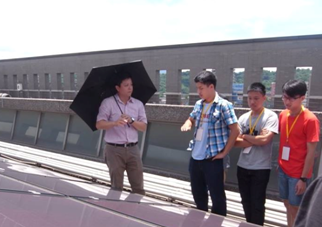 |
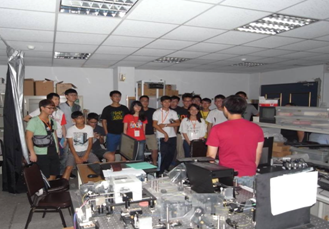 |
|
人稱「光電所彭于晏」的吳肇欣老師(左一) |
實驗室參訪 |
第二天則是前往台中合盈光電及晶元光電的竹南廠進行企業參訪。合盈光電讓我們參訪許多機房,並詳細介紹公司發展的歷史,也提供茶水點心和餐盒,且讓我們體驗用手勢操控來開車的設備,是間非常棒的公司,歡迎台中來的同學以後可以去就業。下午則是前往晶元光電,現場也備有許多點心,但較遺憾的是無法參觀機房只能待在會議室聽大姊姊們介紹,但接待人員也都非常親切!
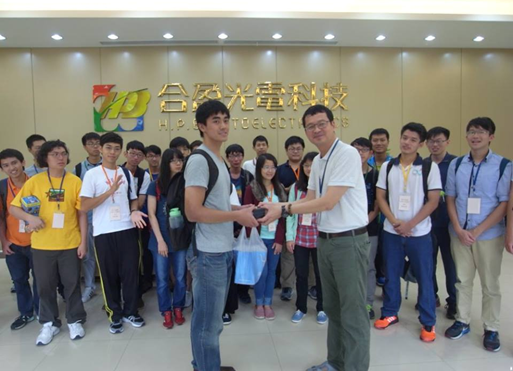 |
|
光電營總召—陳惟裕同學(前排左)
|
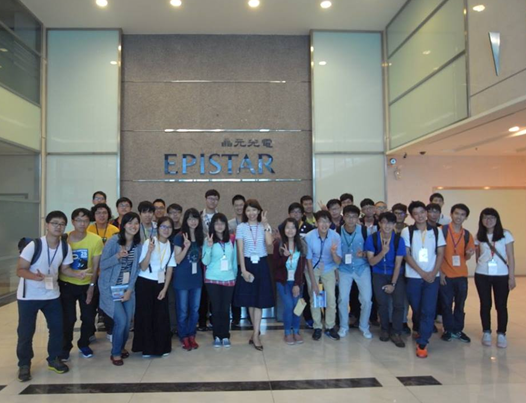 |
|
大合照 |
第三天的上午同學們先聽了教授精彩的演講,接著便是大家最期待的行程—手做實驗!這次的手做實驗課程是實作全息投影(Hologram)以及幻象恐龍(Illusion),我們帶著同學們利用透明的投影膠片來製作出簡單的小型投影機,配合經過特殊後製的影片,便能直接透過這個投影幕看到立體的影像!而另一個幻象恐龍,則是取材自網路,利用薄薄的一張紙摺成的恐龍,卻能營造出緊迫盯人的感覺,不管你的頭怎麼轉,他都會對著你看,看的你心裏毛毛的!這兩項手作實驗都得到了同學們的好評,手作期間同學們彼此間的討論也很熱烈,這對於幕後工作人員的我們來說,就是最大的肯定!
用完了精緻的午餐之後,同學們帶著愉悅的心情迎接最後一門課程,結束之後便是最重要的尾聲—頒發證書!所長簡單致詞後,便在我們所學會同學的協助下,將每位學員的結業證書與光電所精心準備的紀念品親手頒發給大家,相信每位學員在營隊結束之後,一定會將光電營的好宣傳給他們的學弟妹們。而隨著營隊的落幕,我們工作人員也功成身退,相信這幾天的美好回憶會永遠留存在我們心中!
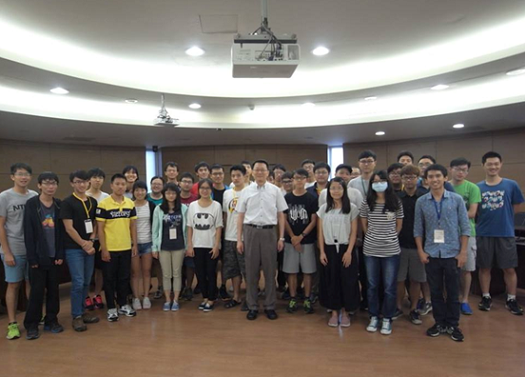 |
|
所長與工作人員、所有學員之大合照 |
|
|
|
|
|
|
|
|
 |
|
 |
|
| |
|
 |
High Efficient Planar Heterojunction Perovskite Solar Cells via Sandwich Evaporation Technique
Professor Ching-Fuh Lin’s laboratory
Graduate Institute of Photonics and
Optoelectronics, National Taiwan University
臺灣大學光電所 林清富教授
Due to the gradual depletion of fossil fuels, the energy issue has received wide attention in this century. The world is making many efforts to develop alternative energy. Solar energy is an inexhaustible and readily available resources on earth. On the top of that, it is eco-friendly to our environment. For these advantages, the development of solar cells has become an excellent strategy to solve the shortage of energy. Among many types of solar cells, perovskite solar cells suddenly appear on the horizon and the conversion efficiency has been made significant progress from 3% to above 20% in just six years.
Although high-efficiency perovskite solar cells have been achieved, perovskite formed by solution process, in general, is very susceptible to the atmosphere and moisture. The perovskite grains usually become small and messy by the rapid formation of perovskite. In this research, we developed a new method using a homemade chamber, called Sandwich Evaporation Technique (SET), to form the perovskite layer, as shown in Fig.1. The process can be mostly conducted in the atmosphere and not be affected by the environment easily. The process includes the following steps. First, we raised a sandwich-like structure, MAI/PbI2/MAI, to fabricate the active layer of perovskite to enhance the current density, as shown in Fig. 2. Second, the perovskite solar cells are fabricated with the traditional structure of ITO/PEDOT-4083/Perovskite/PCBM/PEI/Ag, which can successfully achieve the power conversion efficiency of 14.03%.
|

|
|
Fig. 1. The picture of the homemade chamber of Sandwich Evaporation Technique (SET) process. |
|
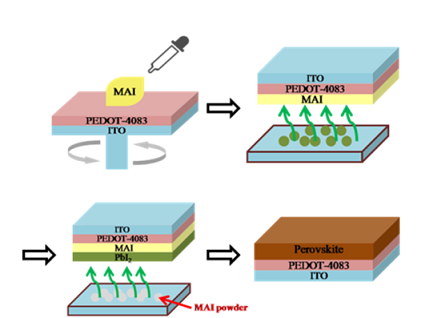
|
|
Fig. 2. The picture of Sandwich Evaporation Technique (SET) process. |
Furthermore, we modify those techniques that can make the better film of the active layer. IPA, CB have been applied on the substrates to slow down the reaction. Here this mechanism is refined for the SET process. Vials with solvent are placed inside the chamber directly. With the refined process, we are able to achieve 14.62% of perovskite solar cells with a higher current density and large crystals of perovskite, as shown in Fig. 3. This brand new method to fabricate the perovskie
under atmosphere environment could potentially
enable the mass production in the future using
the Sandwich Evaporation Technique (SET), as
shown in Fig.4.
|
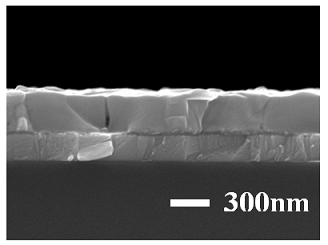
|
|
Fig. 3. The SEM image of the perovskite. |
|

|
|
Fig. 4. The schematic diagram of the Sandwich Evaporation Technique (SET). |
Improved Internal-Quantum Efficiency of GaN-Based LEDs
Professor Chieh-Hsiung Kuan
Graduate Institute of Photonics and
Optoelectronics, National Taiwan University
臺灣大學光電所 管傑雄教授
Instead of the limited exposure feature sizes of conventional photolithography, the ELIONIX ELS-7000 E-beam lithography system and the wet-etching technology were conducted to carry out the investigation. All patterned-sapphire substrates (PSSs) were all arranged in squares with the period of 2000nm and with various post-duty cycles (PDCs) of 1, 4 and 8%, which is defined in Fig. 1(a), respectively. Each square had a hexagonal post. SEM images of accomplished PSSs are shown in Fig. 1(b)-(d). The PSSs and a conventional sapphire substrate (CSS) with polished surface were grown using low pressure metal organic chemical vapor deposition (LP-MOCVD). The light-emitting diodes (LEDs) were encapsulated with TO-46 metal can package with a chip size of 17×34 mil2.
Figure 2 shows the residual compressive strain and the associated Raman width of the GaN-based PSS LEDs. With the increase of PDC, the residual compressive strain of the GaN-based PSS LEDs reduces first and then slightly increases as compared to the sample with the CSS. Fig. 3 shows the relative IQE versus PDC of the GaN-based PSS LEDs biased at injection currents of 120mA and 360mA, respectively. With the increase of PDC in contrast to the CSS, the reduced residual compressive strain leads to the enhanced relative IQE under the same crystalline quality.
|

|
|
Fig. 1. The SEM images of different PSSs and the definition of post-duty cycle |
|
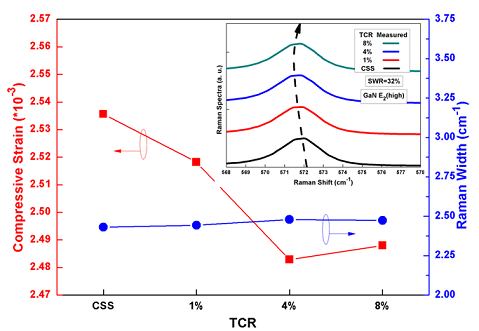
|
|
Fig. 2. The residual compressive strain with the associated Raman width. The inserted figure is the Raman spectra. |
|
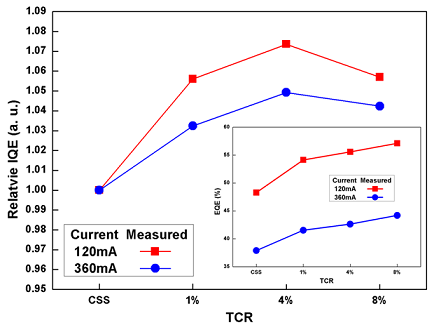
|
|
Fig. 3. The relative IQE of the LEDs, calculated from the inserted figure regarding the EQE versus PDC |
|
 |
| |
|
|
|
 |
|
| |
|
 |
論文題目:表面效應對電阻式記憶體之影響
姓名:柯志堅 指導教授:吳志毅教授、何志浩教授
| 摘要 |
|
在本論文中,我們展示了表面效應對氧化鋅電阻式記憶體(resistive random access memory)的電阻轉換現象有很大的影響。分析了超過400個電阻式記憶體元件在不同氣氛下的電性,我們發現到表面效應(surface effects)對電阻轉換的影響。如圖一所示,在富氧的環境下,氧化鋅電阻式記憶體有較佳的電阻轉換機率。圖二顯示不同氣氛對高阻態(High resistive state)與低阻態(Low resistive state)的影響。分析結果表明氧化鋅表面的吸附氧氣分子與氧缺陷構建的奈米燈絲兩者的交互作用,對電阻式記憶的電阻轉換扮演很重要的角色。此外我們也發現到電阻轉換機率可以藉由表面粗糙度來調控,表面較粗糙的氧化鋅電阻式記憶體有較佳的電阻轉換機率以及在不同氣氛環境下電性較為穩定。我們也做了電極相依性的研究,結果顯示金屬鉑的氣體吸附活化能較低,於是使用鉑作為氧化鋅電阻記憶體的電極有較佳的表現。
|
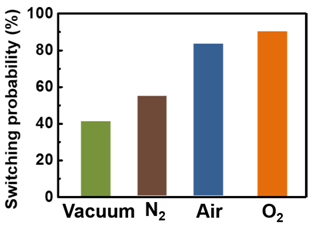 |
 |
|
圖一、不同氣氛下的氧化鋅電阻式記憶體電阻轉換率。富氧環境的轉換率較佳。 |
圖二、不同氣氛對高與低阻態的影響。 |
|
|
|
 |
|
 |
|
| |
|
 |
—
資料提供:影像顯示科技知識平台 (DTKP, Display Technology
Knowledge Platform) —
—
整理:林晃巖教授、林暐杰 —
動量多工技術
美國著名電影製片廠迪士尼,可能是你最不會期望對於光的軌道角動量(orbital angular momentum, OAM)有興趣的組織。不過迪士尼在加州的研究團隊和英國劍橋大學的光子與感測器團隊,正聯手研究根據OAM多工技術為基礎的未來3D顯示器。
近年來關於扭曲的波前攜帶OAM的光束之研究一直非常活躍,主要是由於這類光束可形成一組無限數量的正交模態,每個模態可以由扭轉量唯一定義。這種特性已經被證明,對於提高基於自由空間和光纖的光通信數據容量,是一種有用而創新的多工技術。OAM多工技術是很吸引人的,因為它是一種新的自由度,且和現有常見的基於波長、偏振和時間之多工技術方案可能兼容。
現在Daping Chu和他的同事正在探討利用OAM模態,來表現一個物體之不同視角的影像,然後可以利用多工技術建造一個多視角3D顯示器。目前,研究人員已經展示了基於該方法的三個視角之立體顯示器,將三個不同視角的影像編碼成OAM光束的陣列,則觀看者在空間上可接收到分離的三視角之影像顯示。
|
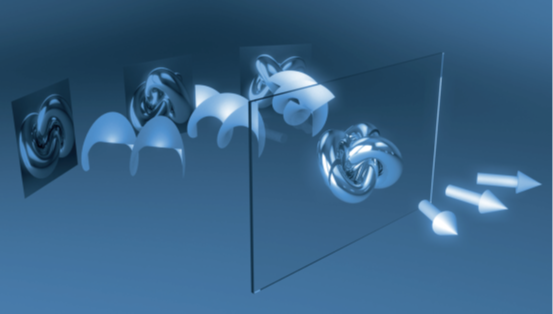 |
|
圖一、利用光的軌道角動量之多視點3D顯示器的示意圖。 |
Chu解釋說:「將其數目規模放大並不會成為一個問題,至少達成幾十個視角影像,換言之將立體影像資訊編碼為更多模態;然而,在技術上的挑戰是如何利用多工與解多工技術,將多個影像在空間上合成與分開。」
|
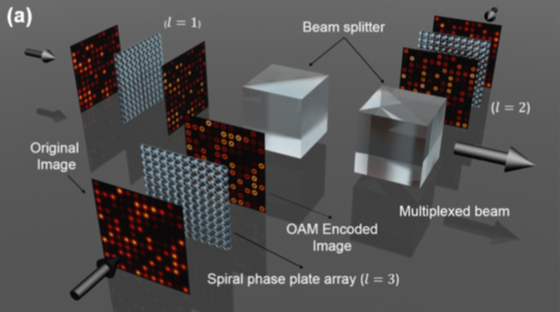 |
|
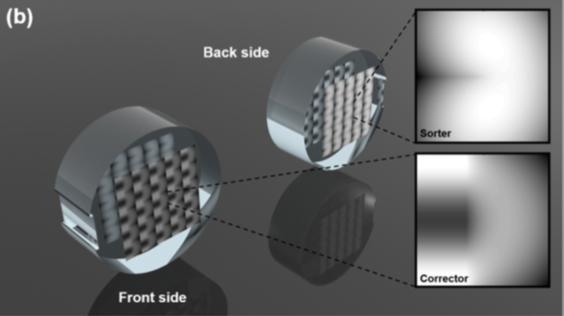 |
|
圖二、(a) 三個OAM狀態之多工傳輸影像的概念圖。(b) 設計分揀器和校正器對於OAM光束晶格陣列進行分揀,其中分揀器和校正器的高度輪廓分別示於插圖。 |
研究團隊首先使用一個螺旋相位板來建立所需的OAM模態,然後使用矽基空間光調制器(LCoS)編碼的達曼光柵(Dammann grating)來複製光束,以此建立9×9正方形晶格排列之相同OAM的光束。然後三個這樣的OAM光束陣列各攜帶不同數量的扭曲波前,被引導到三個影像遮罩以代表物體的不同視角之影像。這些以不同視角影像加以編碼光束,可再用分光束器組合以建立一個多工的輸出。
然後,該輸出經過OAM分揀器進行解多工,分離成為不同的OAM光束,OAM分揀器將具有不同方位角相位梯度(即扭轉的波前量)的OAM光束轉換成一個傾斜平面波,即傳播在不同角度的平面波。目前由於分揀器的設計中,每個視角影像之角度間隔(約0.015°)與傳統的多視角顯示器(其角度間隔通常是0.7°或更大)比較起來是非常小,然而該團隊說,應該可以藉由分檢器的製造來解決這個問題。
至於該研究領域未來的工作中,Chu說該小組目前正在開發一種方法,不需要藉由像素化,直接將2D影像編碼為OAM光束。
|
參考資料: |
1. David Pile, Nature Photonics 10, 570 (2016)
doi:10.1038/nphoton.2016.171 Published online 31 August 2016
2. Li, Xuefeng, et al. "Automultiscopic Displays based on Orbital Angular Momentum of Light." J. Opt. 18 (2016).
doi:10.1088/2040-8978/18/8/085608
|
| |
|
|
|
|
|
|
|
|
|
 |
|
 |
|
|
|
 |
|
 |
|